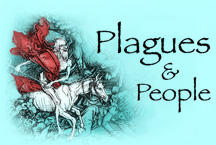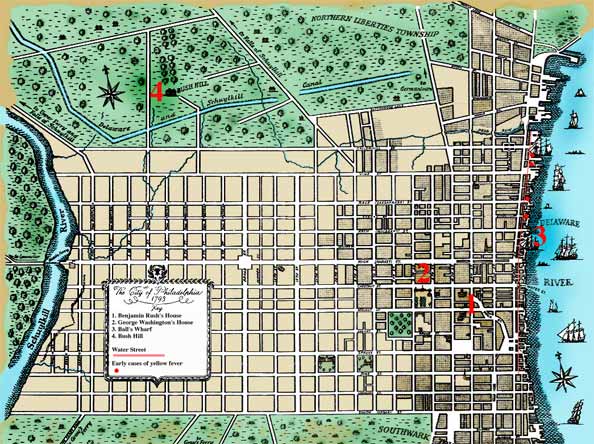| Who was Affected by the Fever
All ages were affected by this fever, but persons between fourteen and
forty years of age were most subject to it. Many old people had it,
but it was not so fatal to them as to robust persons in middle life.
It affected children of all ages....
Men were more subject to the disease than women. Pregnancy seemed
to expose women to it.
The refugees from the French West-Indies universally escaped it.
This was not the case with the natives of France, who had been settled
in the city....
It is difficult to account for these facts. However numerous their
causes may be, a difference in diet, which is as much a distinguishing
mark of nations as dress or manners, will probably be found to be one of
them.
From the accounts of the yellow fever which had been published by many
writers, I was led to believe that the negroes in our city would escape
it....
It was not long after ... Africans undertook the execution of their
humane offer of services to the sick before I was convinced I had been
mistaken. They took the disease in common with the white people,
and many of them died with it. I think I observed the greatest number
of them to sicken after the mornings and evenings became cool. A
large number of them were my patients. The disease was lighter in
them than in white people. I met with no case of hemorrhage in a
black patient.
The tobacconists and persons who used tobacco did not escape the disease....
There did not appear to any advantage from smelling vinegar, tar, camphor,
or volatile salts, in preventing the disease. Bark and wine were
equally ineffectual for that purpose. I was called to many hundred
people who were infected after using one or more of them. Nor did
the white washing walls secure families from the disease. I am disposed
to believe garlic was the only substance that was in any degree useful
in preventing it. I met with several persons who chewed it constantly,
and who were much exposed to the miasmata without being infected.
All other substances seemed to do harm by, begetting a false confidence
in the mind, to the exclusion of more rational preservatives. I have
suspected further, that such of them as were of a volatile nature helped
to spread the disease by affording a vehicle for miasmata through the air.
There was great mortality in all those families who lived in wooden
houses. Whether this arose from the small size of these houses, or
from the want of cleanliness of the people who occupied them, or from the
miasmata becoming more accumulated, by adhering to the wood, I am unable
to determine. Perhaps it was the effect of the co-operation of all
three of those causes....
The State of the Atmosphere
The state of the atmosphere, during the whole month of September, and the
first two weeks in October, favoured the accumulation of the miasmata in
the city.
The register of the weather shows how little the air was agitated by
winds during the above time. In vain were changes in the moon expected
to alter the state of the air. The light of the morning mocked the
hopes that were raised by a cloudy sky, in the evening. The sun ceased
to be viewed with pleasure. Hundreds sickened every day beneath the
influence of his rays: and even where they did not excite the
disease, they produced a languor in the body unknown to the oldest inhabitant
of the city, at the same season of the year.
A meteor was seen at two o'clock in the morning, on or about the twelfth
of September. It fell between Third-street and the hospital
(just south of Rush's house, site 1,
on map of Philadelphia above), nearly in a line with Pine-street.
Mosquetoes (the usual attendants of a sickly autumn) were uncommonly numerous.
Here and there a dead cat added to the impurity of the air of the streets.
It was supposed those animals perished with hunger in the city, in consequence
of so many houses being deserted by the inhabitants who had fled into the
country, but the observations of subsequent years made it more probable
they were destroyed by the same morbid state of the atmosphere which produced
the reigning epidemic.
It appears further, from the register of the weather, that there was
no rain between the 25th of August and the 15th of October, except a few
drops, hardly enough to lay the dust of the streets, on the 9th of September,
and the 12th of October. In consequence of this drought, the springs
and wells failed in many parts of the country. The dust in some places
extended two feet below the surface of the ground. The pastures were
deficient, or burnt up. There was a scarcity of autumnal fruits in
the neighbourhood of the city. But while vegetation drooped or died
from the want of moisture in some places, it revived with preternatural
vigour from unusual heat in others. Cherry-trees blossomed, and apple,
pear, and plum-trees bore young fruit in several gardens in Trenton, thirty
miles from Philadelphia, in the month of October.
However inoffensive uniform heat, when agitated by gentle breezes, may
be, there is, I believe, no record of a dry, warm, and stagnating air having
existed for any length of time without producing diseases. Hippocrates,
in describing a pestilential fever, says the year in which it prevailed
was without a breeze of wind. The same state of the atmosphere, for
six weeks, is mentioned in many of the histories of the plague which prevailed
in London, in 1665. Even the sea air itself becomes unwholesome by
stagnating....
Who can review this account of the universal diffusion of the miasmata
which produced this disease, its universal effects upon persons apparently
in good health, and its accumulation and concentration, in consequence
of the calmness of the air, and believe that it was possible for a febrile
disease to exist at that time in our city that was not derived from that
source?
Circumstances of Public and Private Distress
...[T]he first reports of the existence of this fever were treated with
neglect or contempt. A strange apathy pervaded all classes of people.
While I bore my share of reproach for "terrifying our citizens with imaginary
danger," I answered it by lamenting "that they were not terrified enough."
The publication from the college
of physicians soon dissipated this indifference and incredulity.
Fear or terror now sat upon every countenance. The disease appeared
in many parts of the town, remote from the spot where it originated; although,
for a while, in every instance, it was easily traced to it. This
set the city in motion. The streets and roads leading from the city
were crowded with families flying in every direction for safety to the
country. Business began to languish. Water-street, between
Market and Race-streets (section of Water-street near site 3 on
map of Philadelphia above), became a desert. The poor were the first
victims of the fever. From the sudden inturruption [sic]
of business they suffered for a while from poverty as well as from disease.
A large and airy house at Bush-hill (site 4
on map of Philadelphia above), about a mile from the city was opened for
their reception. This house, after it became the charge of a committee
appointed by the citizens on the 14th of September, was regulated and governed
with the order and cleanliness of an old and established hospital.
An American and French physician had the exclusive medical care of it after
the 22d of September.
The disease, after the second week in September, spared no rank of citizens.
Whole families were confined by it. There was a deficiency of nurses
for the sick, and many of those who were employed were unqualified for
their business. There was likewise a great deficiency of physicians,
from the dissertion of some, and the sickness and death of others.
At one time there were but three physicians who were able to do business
out of their houses, and at this time there were probably not less than
6000 persons ill with the fever.
During the first three or four weeks of the prevalence of the disease
I seldom went into a house the first time without meeting the parents or
children of the sick in tears. Many wept aloud in my entry, or parlour,
who came to ask for advice for their relations. Grief after a while
descended below weeping, and I was much struck in observing that many persons
submitted to the loss of relations and friends without shedding a tear,
or manifesting any other of the common signs of grief.
A cheerful countenance was scarcely to be seen in the city for six weeks.
I recollect once, in entering the house of a poor man, to have met a child
of two years old that smiled in my face. I was strangely affected
with this sight (so discordant to my findings and the state of the city)
before I recollected the age and ignorance of the child. I was confined
the next day by an attack of the fever, and was sorry to hear, upon my
recovery, that the father and mother of this little creature died a few
days after my last visit to them.
The streets every where discovered marks of the distress that pervaded
the city. More than one half the houses were shut up, although not
more than one third of the inhabitants had fled into the country.
In walking for many hundred yards, few persons were met, except such as
were in quest of a physician, a nurse, a bleeder, or the men who buried
the dead. The hearse alone kept up the remembrance of the noise of
carriages or carts in the streets. Funeral processions were laid
aside. A black man, leading or driving a horse, with a corpse on
a pair of chair wheels, with now and then half a dozen relations or friends
following at a distance from it, met the eye in most of the streets of
the city, at every hour of the day, while the noise of the same wheels
passing slowly over the pavements, kept alive anguish and fear in the sick
and well, every hour of the night.
But a more serious source of the distress of the city arose from the
dissentions of the physicians, about the nature and treatment of the fever.
It was considered by some as a modification of the influenza, and by others
as the jail fever [typhus]. Its various
grades and symptoms were considered as so many different diseases, all
originating from different causes. There was the same contrariety
in the practice of the physicians that there was in their principles.
The newspapers conveyed accounts of both to the public, every day.
The minds of the citizens were distracted by them, and hundreds suffered
and died from the delays which were produced by an erroneous opinion of
a plurality of diseases in the city, or by indecision in the choice, or
a want of confidence in the remedies of their physician.
The science of medicine is related to every thing, and the philosopher
as well as the Christian will be gratified by knowing the effects of a
great and mortal epidemic upon the morals of a people. It was some
alleviation of the distress produced by it, to observe its influence upon
the obligations of morality and religion. It was remarked during
this time, by many people, that the name of the Supreme Being was seldom
profaned, either in the streets, or in the intercourse of the citizens
with each other. But two robberies, and those of a trifling nature,
occurred in nearly two months, although many hundred houses were exposed
to plunder, every hour of the day and night. Many of the religious
societies met two or three times a week, and some of them every evening,
to implore the interposition of Heaven to save the city from desolation.
Humanity and charity kept pace with devotion. The public have already
seen accounts of their benevolent exercises in other publications.
It was my lot to witness the uncommon activity of those virtues upon a
smaller scale. I saw little to blame, but much to admire and praise
in persons of different professions, both sexes, and of all colours....
The Domestic Source of the Fever
I have asserted, in the introduction to the history of this fever, that
I believed it to have been generated in our city; I shall now deliver my
reasons for that belief.
|



